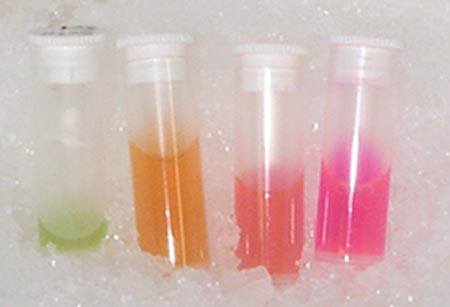
 |
|||||||||||||||
Rubisco (ribulose-1,5-bisphosphate carboxylase oxygenase) is the CO2 assimilating enzyme in all photosynthetic organisms. For unknown reasons, this same enzyme also catalyzes the assimilation of O2 which is a wasteful process called “photorespiration”. This should not be confused with mitochondrial respiration occurring in the light. Over the past 3+ billion years since the appearance of Rubisco, the specificity of Rubisco enzymes has improved from assimilating twenty CO2 molecules for every one O2 molecule to assimilating 90+ CO2 molecules per O2. However, even this higher efficiency is no where near what is theoretically possible based on our knowledge of other enzymes selecting between similar substrates. In addition, all studied Rubsico enzymes have very slow catalytic rates and relatively low affinities for CO2 assimilation. The combination of these three poor catalytic properties explains why some crop plants need to devote up to 50% of their soluble leaf protein in Rubisco in order to achieve high photosynthetic rates.
Improving Rubisco function in crop plants could greatly decrease the amount of water and/or nitrogen a plant needs to maintain high photosynthetic and growth rates. If a better Rubisco has twice the catalytic rate of existing crop enzymes (this would still be pretty slow compared to other enzymes), then a plant expressing that Rubisco would could have the same photosynthetic rate with half the investment in Rubisco - representing a large savings in nitrogen needs of the plant (thereby requiring less fertilizer). However, if a better Rubisco had an increased affinity for CO2, then plants expressing that Rubisco could keep their stomata closed more since they could maintain high photosynthetic rates at lower CO2 concentrations in the leaf. This is important because plants are always balancing the need to keep stomata open to let CO2 into the leaf with the need to keep stomata closed to slow water loss. Because of this trade-off between CO2 uptake and water loss, plants that have Rubisco with a high affinity for CO2 will need less water and could grow in drier climates.
 My
lab is currently studying Rubisco kinetics and activation in Red Algae. Little
data exists on the function of "Red" form, but some published studies
show that it is more efficient then the "Green" plant enzyme. There
is also some suggestion that it's activation properties are different than the
plant enzyme. Our data suggest that some Red form Rubiscos are actually better
than what has been reported in plants making them obvious targets for insertion
into crops. However, no one has been able to get a plant to properly assemble
Red form Rubisco and finding new ways to make this happen is an active research
area of our collaborators.
My
lab is currently studying Rubisco kinetics and activation in Red Algae. Little
data exists on the function of "Red" form, but some published studies
show that it is more efficient then the "Green" plant enzyme. There
is also some suggestion that it's activation properties are different than the
plant enzyme. Our data suggest that some Red form Rubiscos are actually better
than what has been reported in plants making them obvious targets for insertion
into crops. However, no one has been able to get a plant to properly assemble
Red form Rubisco and finding new ways to make this happen is an active research
area of our collaborators.
CO2 concentrating mechanisms in plants (CCMs, see ccm page on my site) create a high CO2 environment around Rubisco to reduce or eliminate photorespiration. This special environment puts different selective pressure on Rubisco (e.g. favoring high catalytic rate over high specificity or affinity) and this is apparent when kinetic properties are compared between species with and without CCMs. My lab is examining this variation in hornworts and algae to test hypotheses about facultative and inefficient CCM systems and to gain a better understanding of the trade-offs between specificity, catalytic rate, and affinity.